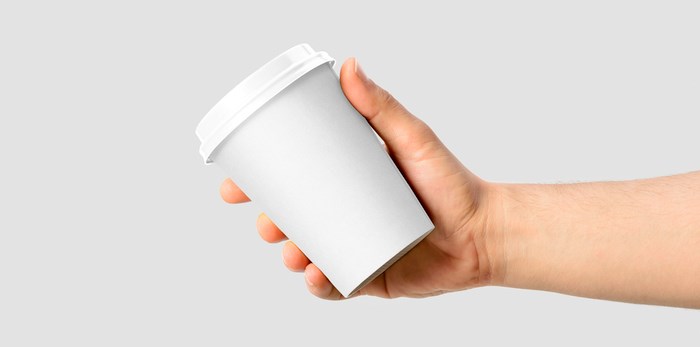Coffee has long been a staple of Canada’s beverage spectrum. Global studies consistently place our country in the top five when measuring the number of litres of coffee that each Canadian consumes.
These studies have their naysayers, who claim that European nations that would never dream of concocting an “Americano” – such as Italy or Spain – cannot compare with Canada’s abundant containers of brewed non-espresso if we are measuring millilitres, and not servings.
 Where do B.C. residents like to get their coffee? Paper coffee cup/Shutterstock.
Where do B.C. residents like to get their coffee? Paper coffee cup/Shutterstock.
With this in mind, Research Co. wanted to take a look at the coffee habits of British Columbians. We focused on consumption outside the home, which places people are more likely to visit or shun when they require caffeine, and just how many have embraced the environmentally friendly concept of using their own mug.
For starters, non-coffee drinkers are a minority. Only one in five British Columbians (20%) say they do not consume coffee outside of their home in a regular week. About three in five (59%) admit to drinking anywhere from one to six cups, while 22% consume seven or more cups of coffee in a week – a proportion that reaches 25% among residents of Metro Vancouver.
When British Columbians who drink coffee outside of their home are asked about their favourite place to get their fix, Tim Hortons is in first place with 43% of the “coffee vote,” followed by Starbucks at 31%. Other chains – such as Blenz, Second Cup and Waves – are in single digits.
Tim Hortons is ahead across all gender and age demographics in British Columbia, Starbucks gets is best showing among women (35%) and residents aged 18 to 34 (also 35%).
On a regional basis, Tim Hortons obliterates the competition in northern B.C. (61%), Â鶹´«Ã½Ó³»Island (53%) and southern B.C. (42%). In coffee-loving Metro Vancouver, the two global brands are practically tied: Tim Hortons is the first choice for 39% of urban coffee drinkers, with Starbucks at 38%.
Coffee drinkers in British Columbia also had strong opinions about the places they would never visit to get a cup of coffee. One in five (20%) say they avoid Tim Hortons, including 25% of those aged 18 to 34 and 24% of those aged 35 to 54. Conversely, 18% of coffee drinkers say they would never visit Starbucks, including 25% of those aged 55 and over.
The rivalry between the two main franchises is powerful as well. More than a third of those who say Starbucks is their favourite place to get coffee (35%) say they never go to Tim Hortons. More than two in five coffee drinkers who express a preference for Tim Hortons (42%) say they always spurn Starbucks.
Last year, Research Co. found that would welcome customers paying an additional fee for the disposable cups they require when purchasing a beverage. Some coffee shops have a different approach, by reducing the price if a customer brings his or her own container.
The coffee-drinking public has not wholeheartedly embraced the concept of the travel mug for regular use. Only 19% of British Columbians who drink coffee outside their home say they always. bring their own mug to the coffee shops, while 24% claim to do this “some of the time.” One-third of coffee drinkers (34%) never bring their own mug, including 40% of women and 48% of British Columbians aged 55 and over.
The prevalance of travel mug users is higher among those who prefer Starbucks (70%) than Tim Hortons (63%). However, as one respondent from Burnaby explained, part of this behaviour may be directly connected to a specific promotion. “No rim to roll on my travel mug,” he wrote.
Two-thirds of British Columbians who drink coffee outside their home (65%) are part of a loyalty program at their favourite coffee shop.
Baby boomers, sometimes derided for their coupon-clipping habits, actually lag behind their younger counterparts on this matter, with 62% of coffee drinkers aged 55 and over joining their favourite shop’s loyalty program. The proportion is higher for those aged 35 to 54 (65%) and those aged 18 to 34 (70%).
Starbucks has had an impressively successful loyalty program for years, so it is not surprising to see 77% of their visitors saying they get “stars” for their purchases in a card or app. The Tim Hortons rewards program was just launched in late March, but we already see 65% of their faithful visitors enrolled.
Still, the numbers suggest that more than a third of coffee-drinking British Columbians are not taking advantage of the opportunity to get free stuff at the places they visit. At a time when discussions about gas prices and taxes are incessant, pinching every penny seems wise. British Columbians who like, love or need caffeine outside of their home could enjoy some benefits by swiping a card or paying with an app.
Results are based on an online study conducted May 2–5, 2019, among 800 adults in British Columbia. The data has been statistically weighted according to Canadian census figures for age, gender and region in British Columbia. The margin of error, which measures sample variability, is plus or minus 3.5 percentage points, 19 times out of 20.


